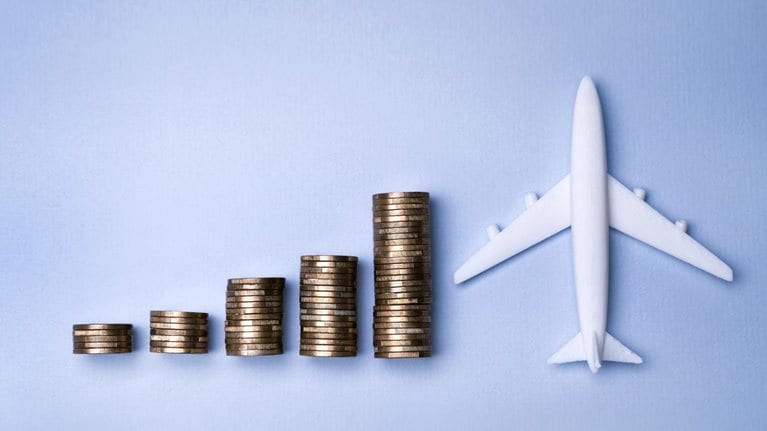The global aviation value chain is made up of a diverse set of sectors that differ in size, structure, and financial performance. Some sectors generate significant profits while others may struggle to maintain profitability. They also differ in the value they create from an investor’s perspective.
Since 2005, McKinsey and IATA have jointly looked at value creation across the aviation value chain to understand what drives performance, and to inform the debate about how to enhance value creation and efficiency across the entire chain.
The focus of this ongoing research is economic value creation, defined as the difference between the return on invested capital (ROIC) and the weighted average cost of capital (WACC). In essence, ROIC measures the earnings available to pay debt and equity investors in relation to the capital invested. The WACC can be seen as the opportunity cost for the investor, as it is a measure of the alternative return the investor could have had if the capital were invested in an asset with a similar risk profile. The difference between these two measures indicates economic profitability: If the ROIC is greater than the WACC, then value is being created. Conversely, if the ROIC is lower than the WACC, then economic value is being lost.
The 2022 edition of the report, Understanding the pandemic’s impact on the aviation value chain, builds on this body of research—and includes a larger sample of companies in each sector—to examine value creation during 2020 and 2021. It examines the ways in which the pandemic affected each sector in the aviation value chain, and looks at performance pre-pandemic, and during COVID-19, as well as recovery.
Sectors analyzed include aircraft and engine original equipment manufacturers (OEMs); lessors; airports; air navigation service providers (ANSPs); ground handlers; maintenance, repair, and overhaul (MRO) providers; catering companies; airlines; global distribution systems (GDSs); and freight forwarders.
The full report dives deeper, by sector, to understand what drives that performance. This article provides an overview of the report’s key findings.
Would you like to learn more about our Travel, Logistics & Infrastructure Practice?
How value creation shifted during the pandemic
Pre-pandemic, the aviation value chain as a whole generated a financial loss of approximately $5 billion a year between 2012 and 2019. This situation was driven by large airline losses as airlines were consistently the weakest link in the chain—generating an economic loss of around $18 billion a year (Exhibit 1). Airlines' under-performance has its roots in factors such as low entry barriers, high exit barriers, sensitivity to external shocks, the fragmented nature of the industry, and a more concentrated supplier landscape, to name a few. This creates a highly challenging environment and has to led to uneven distribution of profits across the value chain.

It’s not surprising that amid lockdowns and travel restrictions, all sectors making up the aviation value chain generated significant losses in 2020 and 2021. As in previous years, airlines showed the greatest losses, at around $175 billion in 2020 and $104 billion in 2021.
While most sectors suffered, the notable exception was air cargo carriers and freight forwarders where supply-demand imbalances (undersupply coupled with sustained demand) led to increases in yields, and value creation. Air cargo was a clear, and much-needed, area of relief during the pandemic. In fact, global air cargo tonnage was roughly 7 percent higher in 2021 than in 2019. In 2021, of the nine value-creating airlines in the sample, seven had significant or pure-cargo operations.
Of the other sectors, those with greater shares of fixed costs, such as airports, suffered more than those with a more variable cost base, such as ground handlers (Exhibit 2).


The six secrets of profitable airlines
Collaboration could expand value creation for all participants
As the aviation value chain is only as strong as its weakest link, all sectors that make up the chain have an interest in one another's ability to perform. It may be possible to strengthen the value chain for everyone, enhance performance of the value chain as a whole, and ensure financial sustainability and value creation for all. Doing so will likely require greater collaboration and cooperation from individual companies across the various sectors. Companies could consider taking the following actions to expand value creation for all participants:
- Working together to improve service and reliability to attract customers. Airlines do not own the end-to-end customer experience, even though they contract directly with the passenger. Enhanced collaboration can benefit all participants in the value chain that depend upon the customers that airlines serve. For instance, all sectors that influence the customer journey (airlines, airports, handlers, caterers and so on) could jointly map the experience so that it can be improved holistically, rather than by one party at a time.
- Pursuing opportunities for greater data and insights sharing across the value chain. Companies within the value chain are starting to put the data-rich environment in which they operate to greater use to provide more tailored offers to customers, or to engage in predictive maintenance. Greater sharing of data and insights, for instance between airlines, airports, and handlers about expected volumes, could lead to better short-term projections and enhanced operational planning.
- Removing inefficiencies in the value chain. Tackling inefficiencies could enhance performance for the whole chain. For example, longer than necessary flight paths within regions lead to air traffic control inefficiencies, additional fuel burn, and associated climate impact. Improvement initiatives, such as Europe's Single European Sky, can help address these inefficiencies, boost profitability, and reduce CO2 emissions for all participants in the chain.
- Working together on decarbonization. Moving the airline industry to net zero by 2050 will require significant investment as well as innovation and value-chain cooperation.
- Collaborating to meet ever-changing demand and customer requirements. In response to changing customer demand, airline business models have become much more hybrid. Today, few airlines are purely low-cost or network carriers, as both have borrowed from each other to adapt their offering. There is also more fluidity among market segments, as business travelers might opt for economy class and leisure travelers may business class for their holiday trips. Greater collaboration—as well as competition and innovation—is vital for offering consumers options that suit their needs.
- Enhancing resilience and robustness. Robustness can be enhanced through creating more diverse revenue streams, as well as paying attention to costs. This might involve vertical and horizontal integration when that is possible, maybe even beyond the aviation value chain. In essence, the goal must be not only to grow, but to grow profitably and sustainably, in order to limit the impacts on the airline industry and the aviation value chain.
Aviation makes a significant economic contribution to societies globally. By jointly working to enhance performance across the value chain, all sectors could be able to generate a return to its investors beyond the minimum based on its risk profile. This requires performance improvement within each sector and also requires greater collaboration and fresh ways of working across partners in the value chain.

